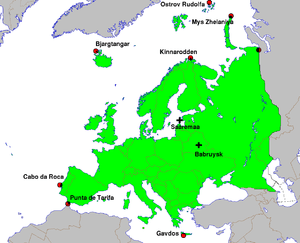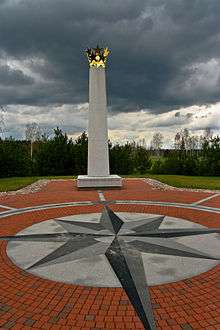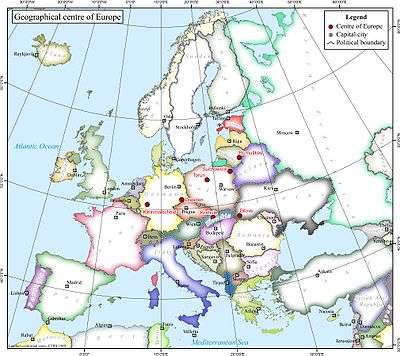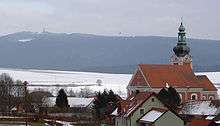Geographical midpoint of Europe
The location of the geographical centre of Europe depends on the definition of the borders of Europe, mainly whether remote islands are included to define the extreme points of Europe, and on the method of calculating the final result. Thus, several places claim to host this hypothetical centre. The first official declaration of the Centre of Europe was made in 1775 by the Polish royal astronomer and cartographer Szymon Antoni Sobiekrajski, and calculated to be in the town Suchowola[1] near Białystok in modern north-eastern Poland. The method used was that of calculating equal distances from the extreme points of Europe: in Portugal (W) vs. Central Ural (E), in Norway (N) vs. Southern Greece (S), (islands were not taken into consideration). There is a monument commemorating that fact in Suchowola 53°34′39″N 23°06′22″E / 53.57750°N 23.10611°E.
Current measurements


After a re-estimation of the boundaries of the continent of Europe in 1989, Jean-George Affholder, a scientist at the Institut Géographique National (French National Geographic Institute) determined that the geographic centre of Europe is located at 54°54′N 25°19′E / 54.900°N 25.317°E.[2] The method used for calculating this point was that of the centre of gravity of the geometrical figure of Europe. This point is located in Lithuania, near the village of Purnuškės. A monument, composed by the sculptor Gediminas Jokūbonis and consisting of a column of white granite surmounted by a crown of stars, was erected at the location in 2004. An area of woods and fields surrounding the geographic centre point and including Lake Girija, Bernotai Hill, and an old burial ground, was set aside as a reserve in 1992. The State Tourism Department at the Ministry of Economy of Lithuania has classified the Geographic Centre monument and its reserve as a tourist attraction. 17 km away lies Europos Parkas, Open Air Museum of the Centre of Europe, a sculpture park containing the world's largest sculpture made of TV sets.[3]
Belarus
In 2000 Belarusian scientists Alexey Solomonov and Valery Anoshko published a report that stated the geographic centre of Europe was located near Lake Sho (55°10′55″N 28°15′30″E / 55.18194°N 28.25833°E; Belarusian: Шо) in Vitsebsk Voblast.[4]
Scientists from the Russian Central Research Institute of Geodesy, Aerial Survey and Cartography (Russian: ЦНИИГАиК) confirmed the calculations of Belarusian geodesists that the geographical centre of Europe is located in Polotsk 55°30′0″N 28°48′0″E / 55.50000°N 28.80000°E. A small monument to the Geographical Centre of Europe was set up in Polotsk on May 31, 2008.[5]
Hungary
It is claimed that a 1992 survey found that the geometric centre of Europe is in the village of Tállya, Hungary 48°14′10″N 21°13′33″E / 48.23610°N 21.22574°E.[6][7] In 2000, a sculpture was erected in the village, with a table on it declaring the place the "Geometric Centre of Europe".[8]
Estonia
It is claimed that if all the islands of Europe – from the Azores to Franz Joseph Land and from Crete to Iceland – are taken into consideration then the centre of Europe lies at 58°18′14″N 22°16′44″E / 58.30389°N 22.27889°E in the village of Mõnnuste, on Saaremaa island in western Estonia. Again, no author and no method of calculation have been disclosed. The local Kärla Parish is seeking to verify the location and to turn it into a tourist location.[9]
Other claimants

Dilove (Rakhiv, Ukraine), Krahule (or Kremnické Bane, Slovakia), Dresden and Kleinmaischeid (Germany), Toruń and Suchowola (Poland), Bernotai, or Purnuškės (Lithuania).
Locations currently vying for the distinction of being the centre of Europe include:
- the village of Kremnické Bane or the neighbouring village Krahule, near Kremnica, in central Slovakia [10]
- the small town of Rakhiv, or the village of Dilove near Rakhiv, in western Ukraine [11]
- the village of Bernotai, or Purnuškės, near Vilnius, in Lithuania [12][13]
- a point on the island of Saaremaa in Estonia [14]
- a point near Polotsk, or in Vitebsk, or near Babruysk, or near lake Sho in Belarus [15]
- a point near the town of Tállya, in north-eastern Hungary [16]
The Guinness World Records recognises Bernotai, as the official geographical midpoint of Europe, but that does not preclude other centres, depending on the methodology used in making the determination.
Historical measurements
Austria-Hungary
.jpg)

- Modern day Slovakia. In about 1815 there was a declaration that the centre of Europe was located near the mining town of Kremnica, on a hill that forms the water division between the basins of the Baltic Sea and Black Sea, near St. John Baptist Church. The method used for calculating it is unknown, but from the description given on the commemorative plaque located near the church 48°44′37″N 18°55′50″E / 48.74361°N 18.93056°E, it seems that it has been the centre of the smallest circle circumscribed on Europe (yet the limits of Europe taken into consideration are not known). The title of the "Centre of Europe" is also claimed by the neighbouring village Krahule (ancient Blaufuß), which used to belong to the same parish, now a famous centre for winter sports, with a hotel and recreation centre called "Stred Európy" ("Centre of Europe").
- Transcarpathia, modern day Ukraine: In 1887, geographers from the Austro-Hungarian Empire set up a historical marker and a large stone in what is today a part of Ukraine, believed to mark the geographic centre of Europe. The interpretation of the worn Latin inscription on the monument is debated, with some claiming that the marker is merely one of a number of fixed triangulation points for surveying purposes established around the territory of the former empire. The external borders of Europe taken into account during the calculations are not known. According to the description, the methodology used for the calculation is that of the geometrical middle point of the extreme latitudes and longitudes of Europe, so the stone was located at 48°30′N 23°23′E / 48.500°N 23.383°E. However, the actual location of the monument seems rather 47°57′46.47″N 24°11′14.4″E / 47.9629083°N 24.187333°E and not the coordinates to which they relate. This is near the village of Dilove located on the Tisza river, close to the Romanian border, in the county of Rakhiv in the Transcarpathian region.
- Modern day Czech Republic/Bavaria: Austrian geographers also marked the 939-metre-high Tillenberg (Dyleň) near the Bohemian city of Eger/Cheb with a copper plate as the centre of Europe. As the border to Germany/Bavaria runs 100 m west of the mountaintop, the German village of Neualbenreuth uses this for promotional purposes. Bayerischer Rundfunk journalists asked the Institut für Geographie of the University of Munich to verify the claims. The institute concluded that the centre lies further to the south, in Hildweinsreuth near Flossenbürg.
Soviet measurements
Measurements done after World War II by Soviet scientists reconfirmed the Austria-Hungarian claim that Rakhiv and Dilove (in Russian: Rakhov and Dyelovoye) to be the geographical centre of Europe. The old marker in the small town was renewed, and a major campaign to convince everyone of its validity was undertaken.
Geographic centre of the European Union
Other locations have claimed the title of geographic centre of Europe on the basis of calculations taking into account only the territory of those states which are members of the European Union (or formerly - European Community).
IGN calculations


As the European Union (EU) has grown in the last 50 years, so has the geographical centre shifted with each expansion.
The French Institut Géographique National (IGN) has been calculating the changing location of what it estimates to be the geographical centre of the EU since at least 1987. Its calculations exclude such extra-European territories of the EU as French Polynesia.
- 12 members: In 1987 the centre of the European Community of the 12 members was declared to be in the middle of France, in the village of Saint-André-le-Coq (63310), département of Puy-de-Dôme (63), région of Auvergne, and next was shifted after the reunification of Germany in 1990 some 25 km north-eastward, to the place called Noireterre in the village of Saint-Clément (03250), département of Allier (03), the same région of Auvergne. A small monument commemorating the latter discovery still exists in Saint Clément.
- 15 members: Using the same techniques, the IGN has identified the geographic centre of the 15-member Union (1995–2004) to be in Viroinval, Belgium, at coordinates 50°00′33″N 4°39′59″E / 50.00917°N 4.66639°E, and a monument there records that finding.
- 25 members: The 25-member Union (2004–2007), had a centre calculated by the IGN to be situated at 50°31′31″N 7°35′50″E / 50.52528°N 7.59722°E, in the village of Kleinmaischeid, Rhineland-Palatinate, Germany.
- 27 members: On January 1, 2007, with the inclusion of Romania and Bulgaria in the European Union, the geographic centre of the European Union changed to a wheat field outside of the German town Gelnhausen, in the state of Hesse, 115 km east of the previous marker, at 50°10′21″N 9°9′0″E / 50.17250°N 9.15000°E.[17]
- 28 members: On July 1, 2013, with the accession of Croatia, the geographic centre entered North-West Bavaria in the place Westerngrund at the river Schulzengrundbach at 50°7′2.23″N 9°14′51.97″E / 50.1172861°N 9.2477694°E. When the French overseas department Mayotte (Indian Ocean island group between Southeast African mainland and Madagascar) joined the EU on 10 May 2014 (as part of France), the geographic center shifted by 500 m to 50°6′8.004″N 9°15′15.91″E / 50.10222333°N 9.2544194°E, still at Westerngrund, beside a path.[18] It is 40 km east of Frankfurt, Germany, which is headquarters to the European Central Bank.
Other calculations
The geographical midpoint of the European Union is not free from disputes, either. If some different extreme points of the European Union, like some Atlantic Ocean islands, are taken into consideration this point is calculated in different locations.
Eurozone
The original centre of the Eurozone is located in France, and in various places for various periods. At some point of time it was near the village of Liernais. This location also changes with the accession of new countries into Eurozone (e.g. Slovakia 2009).
See also
- Central Europe
- Centroid
- Intermediate Region
- Geography of Europe
- Extreme points of the European Union
Further reading
- Gardner, N (November 2005). "Pivotal points: defining Europe's centre". Hidden Europe (5): 20–21. Retrieved 2007-01-11. Useful short English language article that considers the claims of various localities to be the geographical centre of Europe.
A film about the "Center of Europe"
A 2004 Polish-German documentary, Środek Europy (Die Mitte, "The Center"), written and directed by Stanisław Mucha, shows over a dozen different locations.[19]
References
| Wikimedia Commons has media related to Geographical centre of Europe. |
- ↑ http://www.crwflags.com/fotw/flags/pl-pd-sw.html : "In 1775 royal astronomer Szymon Antoni Sobiekrajski published a report in which he stated that Suchowola is the exact geographic centre of Europe"
- ↑ Jan S. Krogh. "Other Places of Interest: Central Europe".
- ↑ "Europos Parkas: Open Air Museum of the Centre of Europe". EU PHARE 2001 Co-operation in the Baltic Sea Region Programme.
- ↑ ".". Belarus Magazine.
- ↑ Российские геодезисты подтвердили нахождение центра Европы в Полоцке - Главные новости - БЕЛТА - новости, события, факты, комментарии
- ↑ "Tállya Online: Európa Mértani Közepe, Tállya". Archived from the original on 2008-05-13. Retrieved 2008-07-01.
- ↑ Cristea, George (2001). Jakten på Europas mittpunkt (in Swedish). Stockholm: Carlsson. ISBN 91-7203-435-1.
- ↑ "Tállya nevezetességei/Közterületi szobrok/Európa mértani középpontja/DSCF6249". Retrieved 2008-07-01.
- ↑ "Kärla vald tahab Euroopa keskpunkti külalistele avada" (in Estonian).
- ↑ http://en.infoglobe.cz/tips-for-trips/svk-kremnicke-bane-geographical-center-of-europe/
- ↑ http://www.lonelyplanet.com/ukraine/the-carpathians/rakhiv/sights/landmarks-monuments/geographical-centre-europe
- ↑ http://www.muziejai.lt/vilnius/europos_geografinis_centras.en.htm
- ↑ http://confluence.org/confluence.php?visitid=14714 : "according to the research of the French National Geographic Institute, the one and only geographical central point of the continent is in Lithuania, a fact that even won recognition in the Guinness Book of World Records"
- ↑ Tapon, Francis (2011). The Hidden Europe: What Eastern Europeans Can Teach Us. SonicTrek. p. 14. ISBN 9780976581222.
- ↑ http://www.belarus-magazine.by/en.php?subaction=showfull&id=1241527298&archive=1252327313&start_from=&ucat=4&
- ↑ http://www.tortenelmi-borut.hu/tallyagr.html : "According to topographical measurements, Tállya is the geodesic centre of [...] continental Europe"
- ↑ Frey, George (2007-01-05). "5 January 2007". Signonsandiego.com. Retrieved 2011-01-03.
- ↑ https://www.openstreetmap.org/search?query=50%C2%B06%E2%80%B28.004%E2%80%B3N%209%C2%B015%E2%80%B215.91%E2%80%B3E
- ↑ "The Center (Die Mitte)". strandfilm.